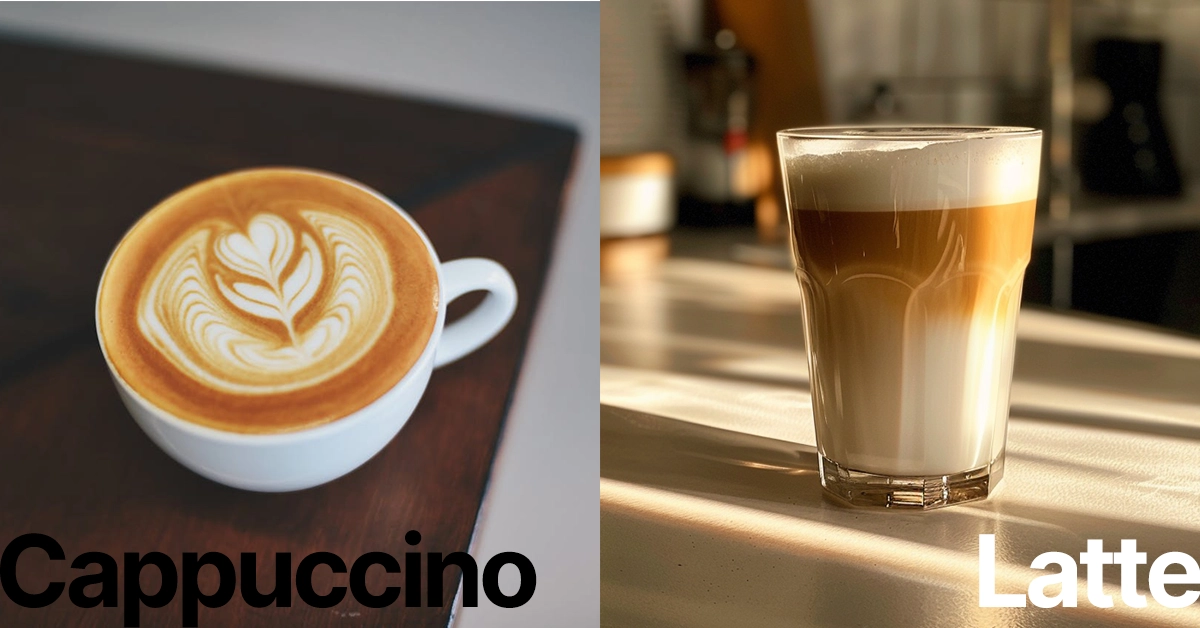In a coffee shop, you’ve got a world of choices, but let’s talk about two classics: cappuccino vs latte. Both are Italian-born, both start with espresso, but each brings its own vibe to your taste buds.
Cappuccino: It’s all about balance with espresso, steamed milk, and foam, giving you a bold, textured taste.
Latte: Creamy and smooth, with lots of steamed milk cuddling up to the espresso for a milder, milkier experience.
Knowing these differences helps you pick the one that’s just right for you.
Cappuccino vs Latte: Key Differences
Quick Explanation: Cappuccino

A cappuccino is traditionally made with equal parts of:
- Espresso
- Steamed milk
- Milk foam
This creates a layered effect, often served in smaller cups which usually range around the size of 5.4-oz (160 ml).
The key to a perfect cappuccino is in the texture and temperature of the milk. When steamed milk is properly heated, it becomes creamy, allowing it to blend harmoniously with the espresso underneath.
To give you a visual, here’s what the structure of a cappuccino looks like:
| Layer | Description |
|---|---|
| 3. Milk Foam | Light and airy on top |
| 2. Steamed Milk | Creamy and smooth in the middle |
| 1. Espresso | Strong coffee flavor as the foundation |
Your cappuccino may have fewer calories compared to other milk-based espresso drinks due to the lower volume of milk involved. Keep in mind that while the proportions are standard, the exact calorie content can vary depending on the choice of milk.
Quick Explanation: Latte

A latte, short for caffè latte, means “milk coffee” in Italian. When you order a latte, here’s what you’re getting:
- Espresso Base: Each latte starts with a shot of espresso.
- Steamed Milk: After the espresso, a generous amount of steamed milk follows. It makes up about two-thirds of the beverage, giving the latte its signature smooth texture.
- Milk Foam Topping: On top of your latte is a modest layer of milk foam, lighter and airier than what you would find on a cappuccino.
Key Ingredients
Both drinks feature two essential ingredients:
- Espresso: A concentrated form of coffee served in shots, which is the base for both drinks.
- Steamed milk: Hot milk with a velvety texture, not too frothy but creamy.
- While milk foam is present in both, it’s more pronounced in cappuccinos. Let’s break down these ingredients by the drink:
| Drink | Espresso | Steamed Milk | Milk Foam |
|---|---|---|---|
| Cappuccino | 1 part | 1 part | 1 part |
| Latte | 1 part | 2 to 3 parts | Thin layer |
Breaking Down the Differences

It’s the finer details that make a world of difference. From texture to flavor and even nutritional content, your choice between a cappuccino and a latte impacts your coffee experience and possibly even your health. Here is a breakdown:
| Aspect | Cappuccino | Latte |
|---|---|---|
| Texture and Layering | – Harmony of layers – Strong textural contrast – Rich and creamy top layer | – Smoother experience – Subtly creamy texture – Minimal milk foam |
| Milk Foam | Substantial, lending a velvety finish to each sip | Minimal, often just a thin layer |
| Flavor Profiles | – Espresso to Milk Ratio: Approximately 1:3 to 1:5 – Robust coffee flavor – Ideal for those who enjoy the flavor of coffee itself | – Espresso to Milk Ratio: Around 1:8 to 1:10 – Milder coffee flavor – Ideal for those who prefer a gentler coffee taste |
| Nutritional Comparison | – Fewer Calories – Moderate protein content – Less milk content | – Higher Calories – Higher protein content – Extra milk increases calorie count |
Nutritional Comparison
When considering your health, both drinks start with a base of espresso, which contains minimal calories and no sugar, but the nutritional value shifts when milk enters the equation.
Origins and Popularity
Cappuccino finds its roots in Italy, where it’s named after the brown robes of the Capuchin monks. In Italy, cappuccinos are typically enjoyed in the morning, not after meals. As the drink moved across the globe, it became a staple in coffee culture, especially in America, where it’s enjoyed throughout the day.
Latte, short for ‘caffè latte,’ means ‘milk coffee’ in Italian. Although its origin is also Italian, the latte has gained significant popularity in America. The American latte tends to come in larger sizes compared to the Italian version and often showcases elaborate milk foam art.
Brewing Techniques
First things first, invest in a good espresso machine or a manual espresso maker because it’s the cornerstone of your home coffee brewing.
Pros
- Compact Design: Ideal for small kitchens or apartments, the compact size ensures it fits seamlessly into limited spaces without compromising functionality.
- Automatic Milk Frother: Offers convenience with an automatic milk frother function, delivering perfectly textured milk for lattes and cappuccinos without manual effort.
- Quick Heating: Heats up rapidly, allowing you to prepare your morning coffee swiftly and efficiently, saving valuable time during busy mornings.
Cons
- Small Water Tank: The water tank's limited capacity may require frequent refilling, especially when making multiple drinks, which could be inconvenient for some users.
To make a cappuccino, follow a 1:1:1 ratio—one-third espresso, one-third steamed milk, and one-third frothed milk. This creates the classic velvety and rich texture you love.
For a latte, aim for a 1:3:1 ratio—one part espresso to three parts steamed milk, and a layer of milk foam on top. When preparing your latte, pour steamed milk over the espresso slowly. Here’s a quick table for reference:
| Coffee Type | Espresso | Steamed Milk | Milk Foam |
|---|---|---|---|
| Cappuccino | 1 Part | 1 Part | 1 Part |
| Latte | 1 Part | 3 Parts | Thin Layer |
💡 Protip
Practice your milk steaming technique to achieve that glossy microfoam. It’s not just how it tastes, but also how it pours that defines the drink’s character.
Remember, fresh, high-quality beans grind just before brewing and water at the optimal temperature (between 195°F and 205°F) are your secret ingredients for a delightful homemade coffee experience.
💡This might interest you as well:
Explore our blog post on Cortado vs Macchiato.
FAQ – Cappuccino vs Latte
Which is stronger latte or cappuccino?
The strength of a beverage refers to the intensity of the coffee flavor. A cappuccino typically offers a stronger taste because it contains equal parts of espresso, steamed milk, and foam, leading to a more pronounced coffee flavor than a latte, which has more steamed milk and a subtler coffee taste.
Is a cappuccino better than a latte for weight loss?
If you’re considering weight loss, a cappuccino might be the better choice between the two. Cappuccinos have less milk than lattes, which means they generally have fewer calories. However, remember that additions like sugar or flavored syrups can increase the calorie count.
Which has more caffeine cappuccino or latte?
Both cappuccinos and lattes typically start with a single shot of espresso and therefore contain the same amount of caffeine. The difference in size or number of espresso shots used can affect the caffeine content, but the default preparation for both drinks has equal caffeine levels.
When should I drink a latte or cappuccino?
Your choice between a latte and a cappuccino may depend on personal preference for a richer or creamier coffee drink. A latte might be your go-to for a gentle, milkier coffee experience, often favored in the morning or afternoon. A cappuccino, with its equal layers and stronger taste, could be better for an early morning or after a meal.
If you liked our blog post on the topic “Cappuccino vs Latte”, don’t forget to leave us a comment down and share your thoughts on this topic.





